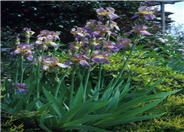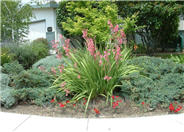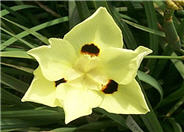
Common name:Wheeler's Dwarf Pittosporum
Botanical name:Pittosporum tobira 'Wheeler's Dwarf'
This handsome dwarf form of the Pittosporum tobira grows into a low, dense mound that is covered with glossy, evergreen foliage.

Common name:White Birch, European White Birch
Botanical name:Betula pendula
This medium-size weeping tree will grow to about 40' tall and has a whitish/brown bark with deciduous green leaves.

Common name:Bearded Iris
Botanical name:Iris Bearded Hybrids
This perennial will grow 1'-3' tall and has medium sized, blue green leaves with flowers of different colors that bloom in spring. It needs well draining soil and full sun. Many are fragrant and rebloom several times a year. Plant rhizomes in Sept or Oct. They need water once a week during the hot spells. Top dress with compost and gypsum in January and August.

Common name:Evergreen Watsonia, Bugle Lily
Botanical name:Watsonia pillansii
Watsonia pillansii is a beautiful perennial that grows 2'-3' tall. It does better in full sun. The orange or red-orange flowers are up to 2" across and bloom from spring through fall. These bulb plants have green foliage that are long, sword-shaped and erect. These are low maintenance plants.

Common name:Yellow Moraea, Fortnight Lily
Botanical name:Dietes bicolor
This clumping perennial Iris relative stands 3'-4' high. It has light yellow, iris-like flowers with maroon blotches that are about 2" wide. It performs best in full sun and in soil with good drainage.
| Designer: | Dry Creek Beds and Perennials |
Photographer: GardenSoft |
Soils and Compost:
Maintain a two to four inch layer of mulch on the soil surface to reduce weeds, infiltrate rain water, and reduce compaction.
Water Saving Tip:
Replace turf with groundcovers, trees, and shrubs. If you have areas where no one uses the grass, patches that do not grow well, or a turf area too small to water without runoff, consider replacing the turf with water-efficient landscaping.
Integrated Pest Management:
Attract, or buy beneficial insects such as ladybugs and lacewings to control pest outbreaks in your garden.

